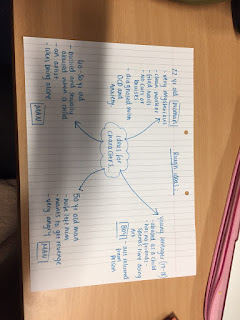LOCATION RESEARCH
Potential locations/settings of our film opening (+ photos):
We plan to create a film opening of a suspense/drama genre, with the idea to focus on specifically the characters, the props, the setting and the titles. Therefore, the location to get the correct setting, the location is particularly important. There are several options and various locations that we can choose to set our film in, but from the start, we have something specific in mind. Ideally, we want a home studio/office in the home of the character (depending on the character we want to have). For instance, the first idea we had was to film somewhere unrecognisable to the audience, so any landmarks were a big no. Instead, we thought the locations had to be personal to the character, somewhere familiar or at least a place where only the character could access/no public outsiders. Going with this theme, our first ideas below are in order of our importance:
- A Home Art Studio:
This could be any room at any of the group's home to act as the characters own personal art studio. This choice is the most realistic as the art studio at school is always busy so we will probably be interrupted which isn't ideal.
- Our School's Art Studio:
Our school has a wonderful and expansive art studio that we could ask to use after school or on a Saturday if the caretakers have opened the school. If this is not possible then between the four of us, we have more enough art products and objects to build a smaller art studio (below).
- A Dark Cellar/Basement:
Any basement that could also act as the characters basement space to work. This could act as more creepy as the other locations and would go with the genre much better.
- A Converted Shed:
This would require more effort as we would actually have to convert a shed if we couldn't already find one.
Weather conditions, schedule, availability, timing, sequences etc...
The film opening location (we hope) to use is only one location, a dark room in a pretend art studio in one of our group's house, where the charcter is to make strange notebooks and other 'things'. We are sure that only one location will be enough, becuase its only the opening to the film, and therefore we shouldn't be giving everything away. Yet, our location also depends on several other factors such as the weather conditions, schedule, availability, timing, sequences. For example, to decide the location we need to know that that place is indeed free and meets the needs in terms of availability, and ideally free for the entire time of our shooting so that when we return to the location, it hasn't changed, and therefore achieving continuity. As for the schedule, all of the crew and cast need to be available and all can get to the location in time, as well as all of the crew knowing the schedule for filming. I think that the schedule will be determined after the dates for filming have been decided so that we know where and when it is happening. The film will be shot inside, so the weather conditions do not affect us in any way, yet they could play to our advantage if we wanted to create a certain atmosphere e.g. if it was raining and we had a shot of the raindrops on the window. The sequences, again, are all going to be shot inside in the relatively same location so the sequences going through each shot and telling the story aren't dramatically going change in terms of location.
Why are these locations so good for what we are trying to achieve?
As we aim for to create a film of the suspense/horror genre, there are several conditions that make this location good. For one, the flexibility of our location is excellent because we can use it at any time of day, especially at weekends. The location has also several lighting options that we can alter and use for how we want it. The area of the room we want to use, also, is enough space for us to try and experiment with what the character can do.
Are we using interior and or/ exterior locations?
We won't be using any exterior locations, only interior settings. This is because we want the feeling of the character being isolated or loneliness in his house, and perhaps not confident to go outside. Only using interior locations creates a feeling of secrecy of the character, and, for the audience, an atmosphere of being alone. The conservatory we are using for the location will have no curtains on, and we plan, to film at night time. This will create a creepy element of the house because it will be black outside while the character works in his art studio.
Do we have back-ups?
We plan to use Daisy's conservatory for the setting of the art studio, with the props surrounding him. However, if plans change and we need to use another location, then any of the homes of our group can be a location if we need to. All of our group have other options we can use, including other rooms, houses, and our school. It also depends on circumstance, availability, schedules and timing on whether everything goes accordingly or something happens to go wrong.
L.R


